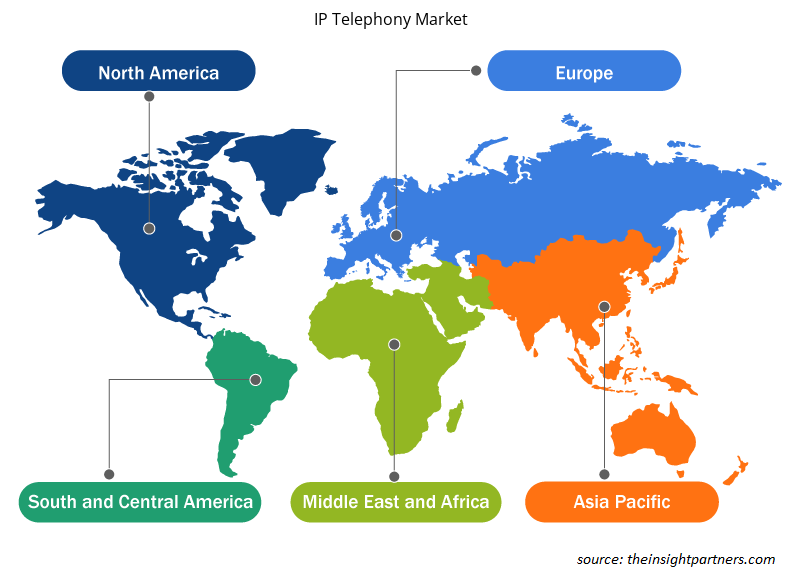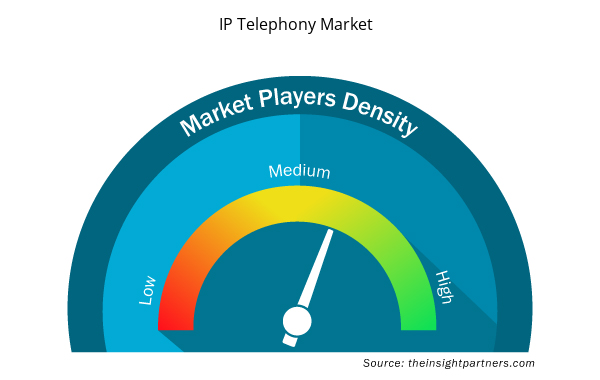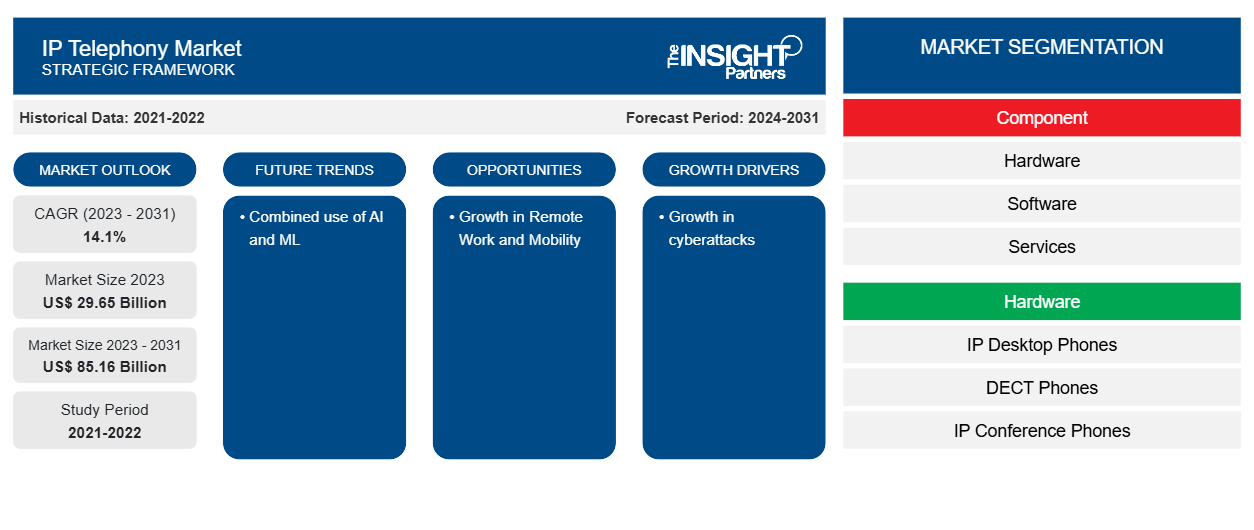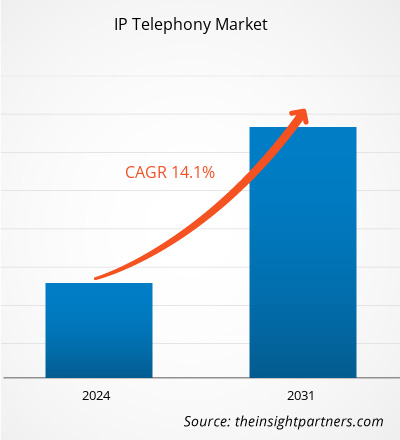Der Markt für IP-Telefonie soll von 29,65 Milliarden US-Dollar im Jahr 2023 auf 85,16 Milliarden US-Dollar im Jahr 2031 anwachsen. Der Markt für IP-Telefonie soll zwischen 2023 und 2031 eine durchschnittliche jährliche Wachstumsrate (CAGR) von 14,1 % verzeichnen. Voice over IP (VoIP) ist ein Dienst und eine Anwendung, die unter den Begriff IP-Telefonie fällt. Dabei handelt es sich um die Übertragung von Sprachkommunikation über IP-Netzwerke.
IP-Telefonie-Marktanalyse
Internet Protocol (IP)-Telefonie bietet eine Vielzahl von Diensten, wie Sprachanrufe, Videoanrufe, Voicemail, Faxen, Instant Messaging (1M) und Videokonferenzen. Im Gegensatz zu VolP bietet IP-Telefonie oft mehr als nur Sprachfunktionen. IP-Telefonie kommt Organisationen jeder Größe zugute, indem sie ein kombiniertes Netzwerk für Telefon- und Internetfunktionen bereitstellt. IP-Telefonie bietet geringere Kosten, eine einfachere Infrastruktur, Skalierbarkeit und Mobilität und ist daher für Endbenutzer attraktiv.
Marktübersicht für IP-Telefonie
IP-Telefonie bezeichnet alle Systeme der internetbasierten Telekommunikation, darunter Fax und andere Technologien. Dabei werden verschiedene Open-Source-Protokolle verwendet, um Daten vom Telefon an den Dienstanbieter zu senden. Unternehmen implementieren IP-Telefonielösungen aufgrund ihrer Portabilität und Kosteneffizienz immer häufiger. Darüber hinaus sind IP-Telefoniesysteme einfach zu verwenden, bieten fortschrittliche Technologien und steigern die Produktivität. Diese Faktoren treiben die Einführung von IP-Telefoniesystemen voran. IP-Telefonie fügt Geschäftstelefonen eine neue Funktion hinzu und verbessert die Kommunikation durch eine kostengünstige Lösung, die als Schlüsselfaktor für den weltweiten IP-Telefoniemarkt gilt. Vorhandene Altsysteme und -hardware wie Faxgeräte , Kreditkartenleser und Alarmanlagen können problemlos mit IP-Telefonsystemen verknüpft werden.
Passen Sie diesen Bericht Ihren Anforderungen an
Sie erhalten kostenlos individuelle Anpassungen an jedem Bericht, einschließlich Teilen dieses Berichts oder einer Analyse auf Länderebene, eines Excel-Datenpakets sowie tolle Angebote und Rabatte für Start-ups und Universitäten.
- Holen Sie sich die wichtigsten Markttrends aus diesem Bericht.Dieses KOSTENLOSE Beispiel umfasst eine Datenanalyse von Markttrends bis hin zu Schätzungen und Prognosen.
Treiber und Chancen auf dem IP-Telefoniemarkt
Zunahme von Cyberangriffen begünstigt den Markt
Der rasante technologische Fortschritt hat in den letzten Jahren zu einer Zunahme von Schwachstellen geführt. Unternehmen verlassen sich zunehmend auf IP-Telefonieprodukte und -dienste, da Cyberangriffe immer häufiger werden. IBM schätzt, dass die Gesamtkosten von Datenschutzverletzungen in Unternehmen allein im Jahr 2021 etwa 6 Billionen US-Dollar betragen werden. Es wird erwartet, dass die Zahlen im erwarteten Zeitraum noch weiter steigen werden. Daher setzen Unternehmen IP-Telefonielösungen ein, um Daten zu schützen und Verstöße zu verhindern, was den durchschnittlichen jährlichen Umsatz (CAGR) des IP-Telefoniemarktes im gesamten Prognosezeitraum ankurbeln dürfte.cyberattacks become more common. IBM estimates that the total cost of data breaches in enterprises will be approximately US$ 6 trillion in 2021 alone. The numbers are expected to rise during the anticipated timeframe. Hence, businesses are deploying IP telephony solutions to protect data and prevent breaches, which is expected to boost the IP telephony market CAGR throughout the forecast period.
Zunahme der Remote-Arbeitskultur
Die zunehmende Nutzung mobiler Geräte und die zunehmende Akzeptanz der Remote-Arbeitskultur treiben die Nachfrage nach adaptiven und schnell verfügbaren IP-Telefonielösungen voran. Mitarbeiter nutzen zunehmend Smartphone-Apps, um von überall aus Anrufe zu tätigen und zu empfangen. Darüber hinaus erfordert die Remote-Zusammenarbeit die Kommunikation mit Videokonferenzsoftware. IP-Telefonieanbieter konzentrieren sich auf die Entwicklung von Lösungen, die diesen sich entwickelnden Anforderungen gerecht werden.
Segmentierungsanalyse des IP-Telefonie-Marktberichts
Wichtige Segmente, die zur Ableitung der IP-Telefonie-Marktanalyse beigetragen haben, sind Komponente, Hardware, Dienst, Installationstyp, Unternehmenstyp und Endbenutzer.
- Basierend auf den Komponenten ist der IP-Telefoniemarkt in Hardware, Software und Dienste unterteilt.
- Nach Hardware ist der Markt in IP-Tischtelefone, DECT-Telefone und IP-Konferenztelefone segmentiert.
- Basierend auf dem Service ist der IP-Telefoniemarkt in Installation und Wartung sowie professionelle Dienstleistungen unterteilt.
- Basierend auf dem Installationstyp ist der IP-Telefoniemarkt in kabelgebundene und kabellose Telefonie segmentiert.
- Basierend auf der Unternehmensgröße ist der IP-Telefoniemarkt in KMU und Großunternehmen segmentiert.
- Basierend auf den Endbenutzern ist der IP-Telefoniemarkt in private, Unternehmens- und staatliche Organisationen segmentiert.
IP-Telefonie Marktanteilsanalyse nach geografischer Lage
Der geografische Umfang des IP-Telefonie-Marktberichts ist hauptsächlich in fünf Regionen unterteilt: Nordamerika, Asien-Pazifik, Europa, Naher Osten und Afrika sowie Süd- und Mittelamerika. Die Ursachen dafür liegen in der weltweiten Zunahme der Einführung von IP-Telefonie-Anwendungen und dem technologischen Fortschritt. Diese Anwendungen werden häufig in bestimmten Branchen wie BFSI, Gesundheitswesen, Einzelhandel, IT und Telekommunikation entwickelt. Darüber hinaus wird erwartet, dass das Wachstum der Region durch die weit verbreitete Nutzung von IP-Telefonie-Diensten, hochmoderne Telekommunikationsinfrastruktur und die Attraktivität der Arbeitsmobilität vorangetrieben wird.
Regionale Einblicke in den IP-Telefoniemarkt
Die regionalen Trends und Faktoren, die den IP-Telefoniemarkt während des Prognosezeitraums beeinflussen, wurden von den Analysten von Insight Partners ausführlich erläutert. In diesem Abschnitt werden auch IP-Telefoniemarktsegmente und -geografie in Nordamerika, Europa, im asiatisch-pazifischen Raum, im Nahen Osten und Afrika sowie in Süd- und Mittelamerika erörtert.

- Erhalten Sie regionale Daten zum IP-Telefoniemarkt
Umfang des IP-Telefonie-Marktberichts
| Berichtsattribut | Details |
|---|---|
| Marktgröße im Jahr 2023 | 29,65 Milliarden US-Dollar |
| Marktgröße bis 2031 | 85,16 Milliarden US-Dollar |
| Globale CAGR (2023 - 2031) | 14,1 % |
| Historische Daten | 2021-2022 |
| Prognosezeitraum | 2024–2031 |
| Abgedeckte Segmente | Nach Komponente
|
| Abgedeckte Regionen und Länder | Nordamerika
|
| Marktführer und wichtige Unternehmensprofile |
|
Dichte der Akteure auf dem IP-Telefoniemarkt: Auswirkungen auf die Geschäftsdynamik verstehen
Der Markt für IP-Telefonie wächst rasant. Die steigende Nachfrage der Endnutzer wird durch Faktoren wie sich entwickelnde Verbraucherpräferenzen, technologische Fortschritte und ein größeres Bewusstsein für die Vorteile des Produkts angetrieben. Mit der steigenden Nachfrage erweitern Unternehmen ihr Angebot, entwickeln Innovationen, um die Bedürfnisse der Verbraucher zu erfüllen, und nutzen neue Trends, was das Marktwachstum weiter ankurbelt.
Die Marktteilnehmerdichte bezieht sich auf die Verteilung der Firmen oder Unternehmen, die in einem bestimmten Markt oder einer bestimmten Branche tätig sind. Sie gibt an, wie viele Wettbewerber (Marktteilnehmer) in einem bestimmten Marktraum im Verhältnis zu seiner Größe oder seinem gesamten Marktwert präsent sind.
Die wichtigsten auf dem IP-Telefoniemarkt tätigen Unternehmen sind:
- Avaya Inc.
- Cisco Systems Inc.
- Gigaset Communications
- LG Electronics Inc.
- Mitel Networks Corporation
- Panasonic Corporation
Haftungsausschluss : Die oben aufgeführten Unternehmen sind nicht in einer bestimmten Reihenfolge aufgeführt.

- Überblick über die wichtigsten Akteure auf dem IP-Telefoniemarkt
Neuigkeiten und aktuelle Entwicklungen zum IP-Telefoniemarkt
Der IP-Telefoniemarkt wird durch die Erhebung qualitativer und quantitativer Daten aus Primär- und Sekundärforschung bewertet, die wichtige Unternehmensveröffentlichungen, Verbandsdaten und Datenbanken umfasst. Nachfolgend sind einige der Entwicklungen auf dem IP-Telefoniemarkt aufgeführt:
- Broadvoice – ein Anbieter gehosteter Sprach-, Unified Communications- und SIP-Trunking-Dienste – gewann die Auszeichnung „Internet-Telefonieprodukt des Jahres 2022“. In den letzten 23 Jahren wurden mit der Auszeichnung VoIP- und IP-Kommunikationsprodukte und -dienste gewürdigt und anerkannt.
(Quelle: Broadvoice, Pressemitteilung, März 2022)
- Pure IP bietet globale Sprachkommunikation für Unternehmen. Es ist jetzt über das Zoom Phone Provider Exchange-System zugänglich. Kunden haben mit diesem Programm mehr Freiheit. Pure IP bleibt erhalten, während das Telekommunikationsnetzwerk an anderen Orten genutzt wird.
(Quelle: Pure IP, Pressemitteilung, April 2023)
Marktbericht zur IP-Telefonie – Abdeckung und Ergebnisse
Der Bericht „IP-Telefonie-Marktgröße und -prognose (2021–2031)“ bietet eine detaillierte Analyse des Marktes, die die folgenden Bereiche abdeckt:
- IP-Telefonie-Marktgröße und -prognose auf globaler, regionaler und Länderebene für alle wichtigen Marktsegmente, die im Rahmen des Berichts abgedeckt sind
- Markttrends im Bereich IP-Telefonie sowie Marktdynamiken wie Treiber, Einschränkungen und wichtige Chancen
- Detaillierte PEST/Porters Five Forces- und SWOT-Analyse
- Analyse des IP-Telefonie-Marktes mit wichtigen Markttrends, globalen und regionalen Rahmenbedingungen, wichtigen Akteuren, Vorschriften und aktuellen Marktentwicklungen
- Branchenlandschaft und Wettbewerbsanalyse, einschließlich Marktkonzentration, Heatmap-Analyse, prominenten Akteuren und aktuellen Entwicklungen für den IP-Telefoniemarkt
- Detaillierte Firmenprofile
- Historische Analyse (2 Jahre), Basisjahr, Prognose (7 Jahre) mit CAGR
- PEST- und SWOT-Analyse
- Marktgröße Wert/Volumen – Global, Regional, Land
- Branche und Wettbewerbsumfeld
- Excel-Datensatz


- Power Bank Market
- Cosmetic Bioactive Ingredients Market
- Aerosol Paints Market
- Saudi Arabia Drywall Panels Market
- Enzymatic DNA Synthesis Market
- Aquaculture Market
- Authentication and Brand Protection Market
- Formwork System Market
- Lyophilization Services for Biopharmaceuticals Market
- EMC Testing Market

Report Coverage
Revenue forecast, Company Analysis, Industry landscape, Growth factors, and Trends

Segment Covered
This text is related
to segments covered.

Regional Scope
North America, Europe, Asia Pacific, Middle East & Africa, South & Central America

Country Scope
This text is related
to country scope.
Häufig gestellte Fragen
The global IP telephony market is expected to reach US$ 85.16 billion by 2031.
The key players holding majority shares in the global IP telephony market are Avaya Inc., Cisco Systems Inc., Gigaset Communications, LG Electronics Inc., and Mitel Networks Corporation.
The combined use of AI and ML is anticipated to play a significant role in the global IP telephony market in the coming years.
The increase in cyberattacks is the major factor propelling the global IP telephony market.
The global IP telephony market was estimated to be US$ 29.65 billion in 2023 The market is expected to register a CAGR of 14.1% during 2023–2031.
Trends and growth analysis reports related to Technology, Media and Telecommunications : READ MORE..
The Insight Partners performs research in 4 major stages: Data Collection & Secondary Research, Primary Research, Data Analysis and Data Triangulation & Final Review.
- Data Collection and Secondary Research:
As a market research and consulting firm operating from a decade, we have published and advised several client across the globe. First step for any study will start with an assessment of currently available data and insights from existing reports. Further, historical and current market information is collected from Investor Presentations, Annual Reports, SEC Filings, etc., and other information related to company’s performance and market positioning are gathered from Paid Databases (Factiva, Hoovers, and Reuters) and various other publications available in public domain.
Several associations trade associates, technical forums, institutes, societies and organization are accessed to gain technical as well as market related insights through their publications such as research papers, blogs and press releases related to the studies are referred to get cues about the market. Further, white papers, journals, magazines, and other news articles published in last 3 years are scrutinized and analyzed to understand the current market trends.
- Primary Research:
The primarily interview analysis comprise of data obtained from industry participants interview and answers to survey questions gathered by in-house primary team.
For primary research, interviews are conducted with industry experts/CEOs/Marketing Managers/VPs/Subject Matter Experts from both demand and supply side to get a 360-degree view of the market. The primary team conducts several interviews based on the complexity of the markets to understand the various market trends and dynamics which makes research more credible and precise.
A typical research interview fulfils the following functions:
- Provides first-hand information on the market size, market trends, growth trends, competitive landscape, and outlook
- Validates and strengthens in-house secondary research findings
- Develops the analysis team’s expertise and market understanding
Primary research involves email interactions and telephone interviews for each market, category, segment, and sub-segment across geographies. The participants who typically take part in such a process include, but are not limited to:
- Industry participants: VPs, business development managers, market intelligence managers and national sales managers
- Outside experts: Valuation experts, research analysts and key opinion leaders specializing in the electronics and semiconductor industry.
Below is the breakup of our primary respondents by company, designation, and region:

Once we receive the confirmation from primary research sources or primary respondents, we finalize the base year market estimation and forecast the data as per the macroeconomic and microeconomic factors assessed during data collection.
- Data Analysis:
Once data is validated through both secondary as well as primary respondents, we finalize the market estimations by hypothesis formulation and factor analysis at regional and country level.
- Macro-Economic Factor Analysis:
We analyse macroeconomic indicators such the gross domestic product (GDP), increase in the demand for goods and services across industries, technological advancement, regional economic growth, governmental policies, the influence of COVID-19, PEST analysis, and other aspects. This analysis aids in setting benchmarks for various nations/regions and approximating market splits. Additionally, the general trend of the aforementioned components aid in determining the market's development possibilities.
- Country Level Data:
Various factors that are especially aligned to the country are taken into account to determine the market size for a certain area and country, including the presence of vendors, such as headquarters and offices, the country's GDP, demand patterns, and industry growth. To comprehend the market dynamics for the nation, a number of growth variables, inhibitors, application areas, and current market trends are researched. The aforementioned elements aid in determining the country's overall market's growth potential.
- Company Profile:
The “Table of Contents” is formulated by listing and analyzing more than 25 - 30 companies operating in the market ecosystem across geographies. However, we profile only 10 companies as a standard practice in our syndicate reports. These 10 companies comprise leading, emerging, and regional players. Nonetheless, our analysis is not restricted to the 10 listed companies, we also analyze other companies present in the market to develop a holistic view and understand the prevailing trends. The “Company Profiles” section in the report covers key facts, business description, products & services, financial information, SWOT analysis, and key developments. The financial information presented is extracted from the annual reports and official documents of the publicly listed companies. Upon collecting the information for the sections of respective companies, we verify them via various primary sources and then compile the data in respective company profiles. The company level information helps us in deriving the base number as well as in forecasting the market size.
- Developing Base Number:
Aggregation of sales statistics (2020-2022) and macro-economic factor, and other secondary and primary research insights are utilized to arrive at base number and related market shares for 2022. The data gaps are identified in this step and relevant market data is analyzed, collected from paid primary interviews or databases. On finalizing the base year market size, forecasts are developed on the basis of macro-economic, industry and market growth factors and company level analysis.
- Data Triangulation and Final Review:
The market findings and base year market size calculations are validated from supply as well as demand side. Demand side validations are based on macro-economic factor analysis and benchmarks for respective regions and countries. In case of supply side validations, revenues of major companies are estimated (in case not available) based on industry benchmark, approximate number of employees, product portfolio, and primary interviews revenues are gathered. Further revenue from target product/service segment is assessed to avoid overshooting of market statistics. In case of heavy deviations between supply and demand side values, all thes steps are repeated to achieve synchronization.
We follow an iterative model, wherein we share our research findings with Subject Matter Experts (SME’s) and Key Opinion Leaders (KOLs) until consensus view of the market is not formulated – this model negates any drastic deviation in the opinions of experts. Only validated and universally acceptable research findings are quoted in our reports.
We have important check points that we use to validate our research findings – which we call – data triangulation, where we validate the information, we generate from secondary sources with primary interviews and then we re-validate with our internal data bases and Subject matter experts. This comprehensive model enables us to deliver high quality, reliable data in shortest possible time.


 Holen Sie sich ein kostenloses Muster für diesen Bericht
Holen Sie sich ein kostenloses Muster für diesen Bericht